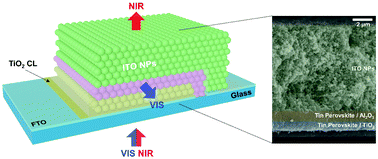Solution-processed ITO nanoparticles as hole-selective electrodes for mesoscopic lead-free perovskite solar cells†
Abstract
Carbon-based mesoscopic perovskite solar cells (PSCs) are promising for printable next-generation photovoltaic applications, but the optical properties of their carbon layer limit their light harvesting efficiency. We developed solution-processable indium-tin-oxide (ITO) nanoparticles to replace carbon electrodes for mesoscopic lead-free tin-based PSCs. The ITO electrodes were fabricated via screen printing with 1, 2, 4, 6 and 8 layers corresponding to the thicknesses of 2.1–14.3 μm; tin perovskite (GA0.2FA0.8SnI3) with SnF2 (20%) and EDAI2 (15%) (GA represents guanidinium; EDAI2 represents ethylenediammonium diiodide) was drop-casted on the device to produce a mesoporous structure of FTO/TiO2/perovskite/Al2O3/ITO. The best device achieved a power conversion efficiency of 5.4% with great stability. These solution-processed ITO electrodes are a landmark to shed light on new paths for the commercialization of lead-free PSCs.

- This article is part of the themed collection: Perovskites


 Please wait while we load your content...
Please wait while we load your content...